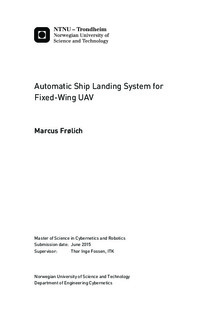Automatic Ship Landing System for Fixed-Wing UAV
Master thesis
Permanent lenke
http://hdl.handle.net/11250/2352446Utgivelsesdato
2015Metadata
Vis full innførselSamlinger
Sammendrag
This thesis presents the system design of an automatic ship landing system for a fixed-wing unmanned aerial vehicle UAV) intended to land in a net. It involves path planning, guidance and control, accurate navigation and ship motion prediction. Fully functional, the automatic landing system is intended to remove the need for a pilot when operating UAVs from a ship or other platforms with confined space.
Dynamic flight paths for landing were developed using both piece-wise continuous interpolation (for simplicity) and Dubins path (for feasibility). The system uses the Pixhawk autopilot and a software toolchain from Underwater Systems and Technology Laboratory (LSTS), Porto, for vehicle control, mission review and communication. Either waypoints or climb rate and bank angle commands can be calculated in the LSTS toolchain and sent to Pixhawk. Real-Time Kinematic GPS (RTK-GPS) is used for accurate navigation. To ensure safe landing on a ship influenced by wind, waves and current, artificial neural network (ANN), an artificial intelligence (AI) method, is used for ship motion prediction.
Software-in-the-loop (SIL) simulations demonstrated successful performance of the automatic landing system, where the UAV hit the landing target with reasonable accuracy. This was done by developing a decoupled guidance system to send climb rate and bank angle commands to the Pixhawk. Using simulated data from a ship influenced by waves and current, the ANN ship motion prediction system sufficiently performed predictions of heading and heave displacement for up to 60 seconds. A novel approach to ANN pre- and post-processing was found to increase heading prediction accuracy compared to conventional approaches, while ANN data fusion increased the performance and robustness of heave prediction compared to using a single data type.
